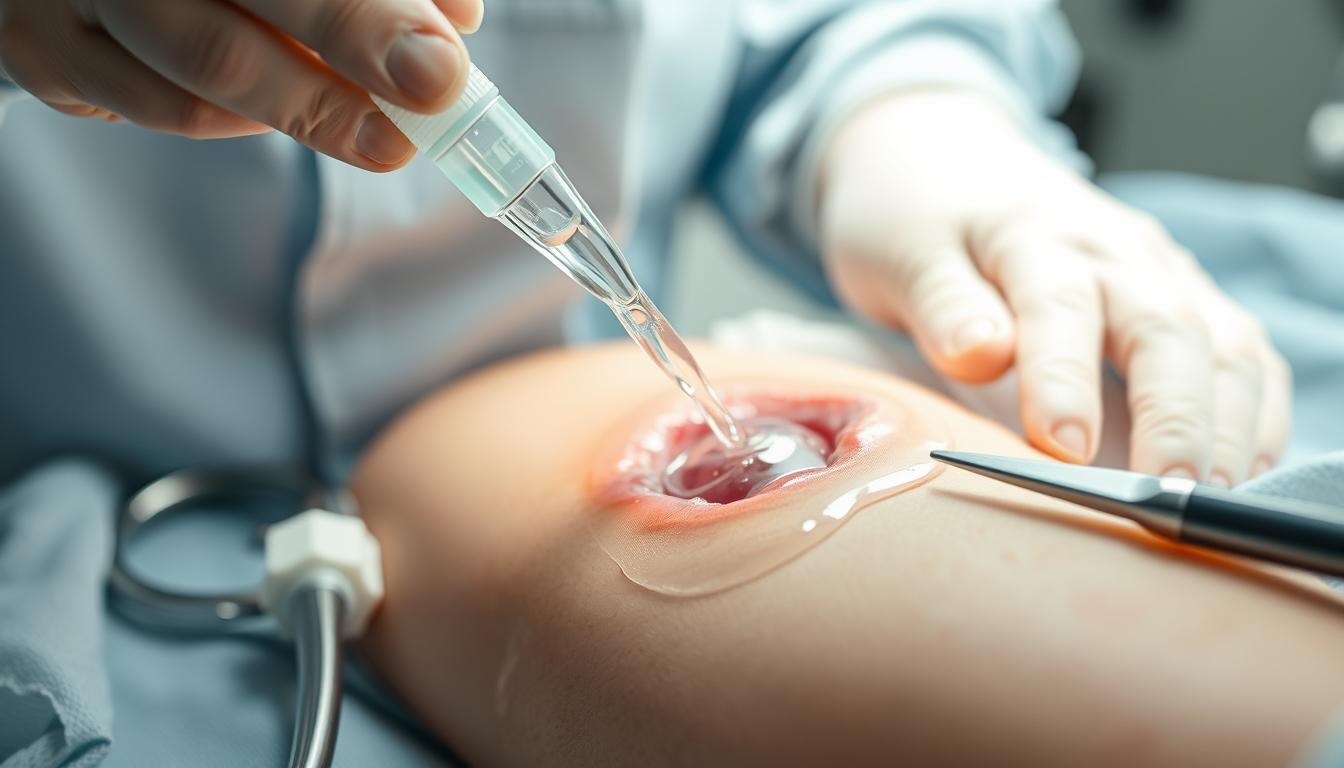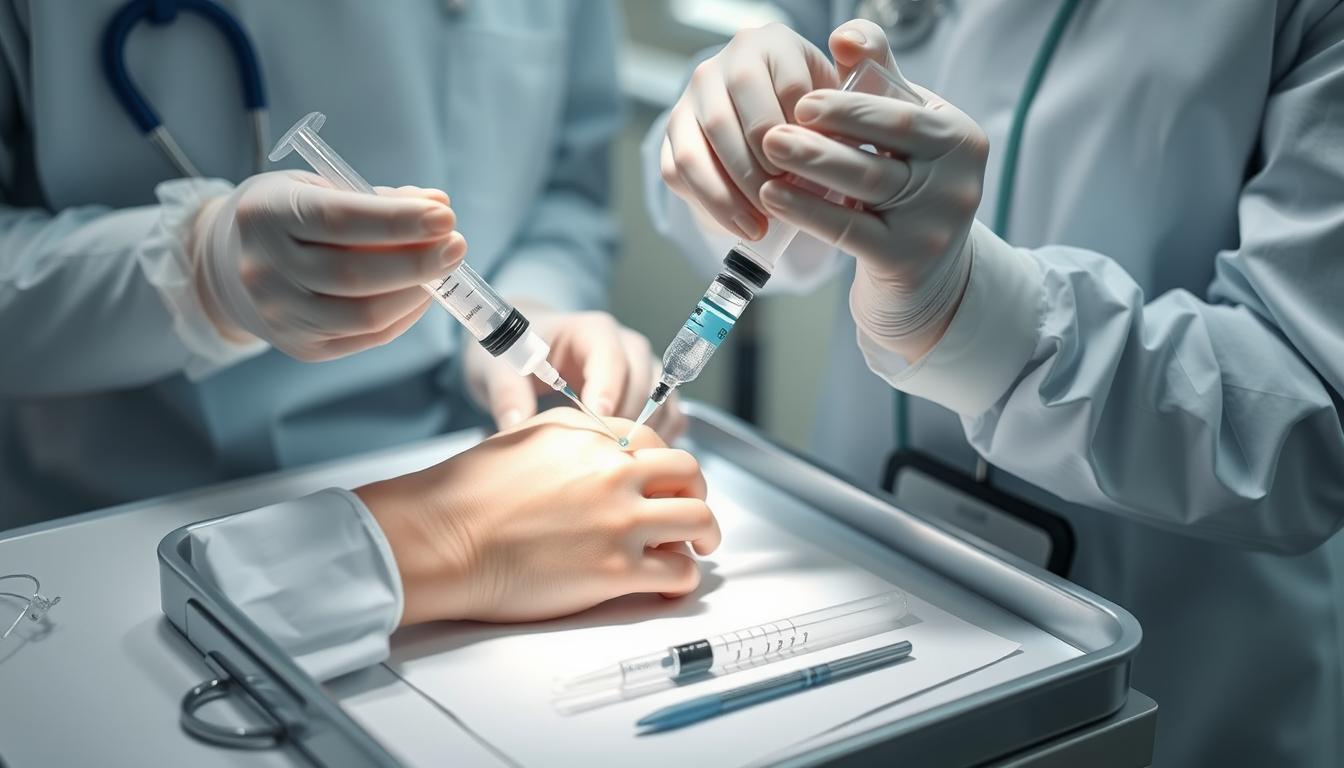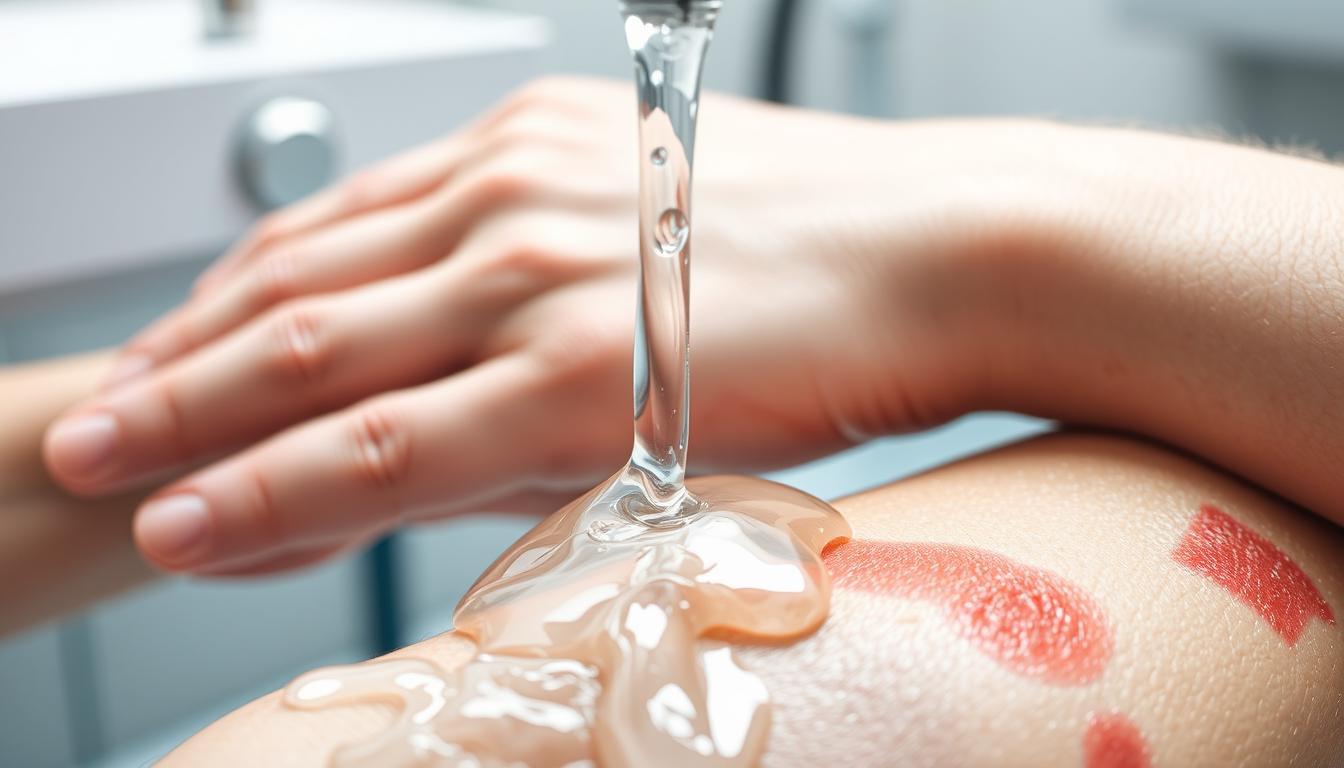Effective Wound Irrigation Solution for Faster Healing
5th Oct 2024
Proper wound care is key for quick healing and avoiding problems. Effective wound irrigation is a must. It cleans the wound, removing dirt, bacteria, and other harmful stuff. This article looks into how wound irrigation solutions help speed up healing and improve patient recovery.

Key Takeaways
- Effective wound irrigation is crucial for promoting faster healing and preventing infections.
- Proper wound cleansing can remove debris, bacteria, and other contaminants that impede the healing process.
- Choosing the right wound irrigation solution is essential for optimizing healing outcomes.
- Understanding the proper technique for wound irrigation is important to ensure effective and safe application.
- Biofast Healthcare Supplies offers trusted and high-quality wound irrigation solutions to support Australian healthcare professionals.
Understanding the Importance of Wound Irrigation
Proper wound irrigation is key to healing wounds. It's not just a quick clean. It's a crucial step that helps prevent infection and speeds up recovery. By knowing the benefits and clearing up myths, Australians can see how vital wound irrigation is.
Benefits of Proper Wound Cleansing
Thorough wound irrigation brings many benefits. It helps to:
- Remove debris, dirt, and contaminants from the wound site, reducing the risk of infection
- Flush out bacteria and other microorganisms that can delay or complicate the healing process
- Prepare the wound bed for further treatment, such as dressing application or suturing
- Promote optimal conditions for the body's natural healing mechanisms to take effect
Common Misconceptions about Wound Irrigation
Despite its benefits, some myths about wound irrigation exist. These myths can harm proper wound care. Some common misconceptions include:
- Wound irrigation is only necessary for large or deep wounds. In fact, proper cleansing is important for all types of wounds, regardless of size or depth, to prevent infection and support healing.
- High-pressure irrigation can further damage the wound. While extremely high pressure should be avoided, moderate-pressure irrigation is generally safe and effective for most wounds.
- Water is just as good as a specialized wound irrigation solution. While tap water may be an option in some cases, sterile wound irrigation solutions are specifically formulated to be gentle yet effective in cleansing the wound.
By clearing up these myths and understanding wound irrigation's importance, Australians can actively support their wound care. This helps their body heal naturally.
The Role of Wound Irrigation Solutions in Healing
Wound irrigation solutions are key in helping wounds heal. They create the best environment for the body's healing to work well. This leads to quicker recovery and better results for patients.
These solutions are mainly used to reduce the risk of infection. They clean the wound by removing dirt, bacteria, and other harmful stuff. This stops bad germs from slowing down or making healing harder.
Also, wound irrigation solutions help get rid of dead tissue that slows healing. They clean the wound, making it ready for the body to start fixing itself.
Proper irrigation keeps the wound's moisture just right. This is vital for healing. If the wound gets too dry, it heals slower and can get worse.
"Effective wound irrigation is a critical step in the wound healing process, as it helps create an optimal environment for the body to repair itself."
Wound irrigation solutions also boost the body's healing response. They help cells move in to fix the wound. This makes healing faster and cuts down recovery time.
Knowing how wound irrigation solutions help, healthcare pros can choose the best treatments. This leads to better results and quicker healing for patients.
Choosing the Right Wound Irrigation Solution
Choosing the right wound irrigation solution is key. The type of wound, its severity, and the patient's medical history are important. Also, the solution's antimicrobial properties, pH balance, and compatibility with other products need to be considered.
Factors to Consider
- Wound type (e.g., acute, chronic, surgical)
- Wound characteristics (e.g., size, depth, contamination level)
- Patient's medical history (e.g., allergies, underlying conditions)
- Desired solution properties (e.g., antimicrobial, pH-balanced, non-cytotoxic)
- Compatibility with other wound care products
Common Types of Solutions
Healthcare professionals have many types of wound irrigation solutions to choose from. Each has its own properties and uses. Here are some common ones:
| Solution Type | Key Features | Typical Use |
|---|---|---|
| Saline Solution | Isotonic, non-cytotoxic, low-cost | General wound cleansing, removal of debris |
| Antiseptic Solutions | Antimicrobial properties, can be cytotoxic | Heavily contaminated or infected wounds |
| Surfactant-Based Solutions | Improved wetting and penetration | Wounds with necrotic tissue or biofilm |
| Hypochlorous Acid Solutions | Antimicrobial, pH-balanced, non-cytotoxic | Broad-spectrum wound care, including chronic wounds |
By looking at the factors for wound irrigation solution and the options available, healthcare professionals can make the best choice. This helps in promoting optimal wound healing and better patient outcomes.
Proper Technique for Wound Irrigation
Keeping up with the right wound irrigation method is key for the best healing. A good clean helps get rid of dirt and stops infections. This speeds up the healing process. Here's how to do it right.
Step-by-Step Guide
- Prepare the Irrigation Solution: Pick the right solution, like saline or sterile water, for your wound. Your doctor will tell you what's best.
- Gather the Necessary Equipment: Make sure you have a clean syringe, tubing, and a container for the used solution.
- Position the Patient: Put the patient in a comfy spot. This makes it easy to get to the wound and keeps them safe.
- Irrigate the Wound: Use the solution to clean the wound with a syringe or tubing. Make sure it's gentle and steady. Don't use too much pressure.
- Repeat as Needed: If the wound is big or complex, clean it again until it looks clean and free of dirt.
- Dry the Wound: Pat it dry with a clean, sterile gauze. Be gentle to avoid irritating the wound.
- Apply Dressing: Put on the dressing your doctor told you to use. It helps protect the wound and aid in healing.
Using the right wound irrigation technique is vital for effective wound cleansing and quick wound healing. By following these steps, you can give your wound the care it needs to heal well and fast.

Wound Irrigation Solution: When to Use and How Often
Using the right wound irrigation solution at the right time is key for faster healing. It helps prevent complications too. Let's look at when and how often to do wound irrigation to help your wounds heal well.
Timing of Wound Irrigation
The timing of wound irrigation depends on the wound type and stage. Generally, wounds should be irrigated at each dressing change. This removes debris, bacteria, and dead tissue.
- For acute wounds, like cuts or scrapes, do it at least once a day. Do it more often if the wound looks dirty or contaminated.
- For chronic wounds, like pressure sores or diabetic foot ulcers, do it several times a week. This keeps the wound clean and moist for healing.
Optimal Wound Irrigation Schedule
The best schedule for wound irrigation varies by patient and wound. Here's a general guide:
- First irrigation: Do a thorough irrigation when you first see the wound or at the first dressing change.
- Regular irrigation: Keep irrigating the wound at each dressing change. This is usually daily or every other day, based on the wound and its progress.
- Less frequent irrigation: As the wound heals, you can do irrigation less often. Try two or three times a week.
Adjust the irrigation frequency based on the wound's look, drainage, and how well it's healing. Talk to your healthcare provider to find the best schedule for you.
By sticking to these guidelines, you can make sure your wound gets the cleaning it needs. This helps it heal faster and lowers the chance of infection or other problems.
Wound Irrigation Solution for Different Types of Wounds
Not all wounds are the same. The type of wound affects the best irrigation solution. We'll look at how to tailor irrigation for acute and chronic wounds.
Acute Wounds
Acute wounds, like cuts or surgical incisions, need a gentle approach. These wounds are fresh and haven't developed complications yet. A saline-based solution is usually best for them. It cleans out debris and bacteria without harming the healing process.
Chronic Wounds
Chronic wounds, like pressure ulcers, are tougher. They may have more bacteria and need a stronger solution. Solutions with antimicrobial agents, like polyhexanide or octenidine, can help fight infection and aid healing.
Wound irrigation aims to clean and prepare wounds for healing. Choosing the right solution for each wound type helps healthcare professionals. This ensures wounds heal well and reduces complications.
| Wound Type | Recommended Wound Irrigation Solution |
|---|---|
| Acute Wounds | Saline-based solution |
| Chronic Wounds | Antimicrobial-containing solution (e.g., polyhexanide, octenidine) |
Choosing the right irrigation solution is key in wound care. Understanding acute and chronic wounds' needs helps healthcare professionals. This targeted care supports faster healing and better patient outcomes.

Wound Irrigation Solution: Precautions and Safety Measures
Using wound irrigation solutions needs careful thought and safety first. These solutions help clean and heal wounds but must be used right to work well. They are important for the patient's health and healing.
The big worry with wound irrigation solutions is infection. If not used right or if the solution is dirty, it can bring in bad bacteria. This makes healing harder. Always use clean, sterile equipment and only the best wound irrigation solutions.
- Make sure the wound irrigation solution fits the wound and the patient's health.
- Don't use wound irrigation solutions with extra stuff in them. It can make the wound sore and slow healing.
- Watch for any bad reactions like redness or more pain. Stop using it if you see these signs.
It's also key to get the pressure and amount of solution right. Too much can hurt the tissue, and too little won't clean the wound well. Always follow the maker's advice and talk to doctors to find the best way for each patient.
"Ensuring the safe and effective use of wound irrigation solutions is paramount in delivering the best possible outcomes for our patients."
By following these steps, healthcare workers can make sure wound irrigation solutions are safe and work well. This helps patients heal faster and better. Always stay careful and use the best practices for ensuring safe wound irrigation and getting the most from these tools.
Wound Irrigation Solution from Biofast Healthcare Supplies
Choosing the right irrigation solution is key for effective wound healing. Biofast Healthcare Supplies in Australia offers a range of Biofast wound irrigation solutions. These solutions help wounds heal faster and better.
Biofast is known for its high-quality Biofast healthcare supplies. Their wound irrigation products are carefully made and tested. They clean wounds well and fight off infections, helping wounds heal quickly.
Trusted Products and Quality
Biofast's wound irrigation solutions are trusted and work well. They are made with great care and meet top standards. This ensures they are safe and effective for everyone.
- Formulated with advanced antimicrobial agents to prevent infection and support healing
- Gentle on delicate tissue, minimizing discomfort and promoting a more comfortable healing process
- Backed by extensive clinical research and a commitment to quality assurance
- Readily available and accessible through Biofast's extensive distribution network
Healthcare providers can rely on Biofast's Biofast wound irrigation solutions. These products help them give the best care and support their patients' recovery.
Wound Irrigation Solution: Optimizing Healing and Recovery
Effective wound irrigation solutions are key to better healing and recovery. Proper cleaning and the right solutions help wounds heal faster. This leads to better results for patients.
Wound irrigation solutions remove dirt, bacteria, and dead tissue. This reduces infection risk and helps wounds heal. They also boost the body's healing process, speeding up tissue repair.
The right solution can change how a wound heals. Antimicrobial solutions stop harmful bacteria, while anti-inflammatory ones reduce swelling and pain. This makes recovery more comfortable.
| Irrigation Solution | Key Benefits |
|---|---|
| Saline Solution |
- Effectively removes debris and contaminants
- Gentle and non-irritating |
| Antimicrobial Solutions |
- Inhibits the growth of harmful bacteria
- Reduces the risk of infection |
| Anti-inflammatory Solutions |
- Reduces swelling and pain
- Promotes comfort during the healing process |
Healthcare professionals can improve wound healing by choosing the right solution and using proper techniques. This leads to faster healing, fewer complications, and happier patients.
"Effective wound irrigation is a critical step in the healing process, as it sets the stage for optimal tissue repair and regeneration."
Conclusion
This article has covered the importance of effective wound irrigation solutions. It showed how they help wounds heal faster. Readers learned about the benefits of cleaning wounds properly and the role of different solutions.
They also found out how to use these solutions correctly. Knowing what to look for in a solution and following the right steps helps in wound care. This ensures the best results for patients.
It's important to know the facts and take safety precautions when using these solutions. This article has given readers the knowledge to make good choices in wound care. It aims to help wounds heal quickly and improve patient recovery.
FAQ
What are the benefits of proper wound cleansing?
Cleaning wounds properly stops infections, removes dirt, and helps wounds heal faster. This leads to quicker recovery times.
What are some common misconceptions about wound irrigation?
Some think wound irrigation is not needed or can harm the wound. But, it's key for healing and avoiding problems.
How do wound irrigation solutions help in the healing process?
Solutions for wound irrigation cut down infection risks, clear out debris, and aid in healing. This results in faster recovery.
What factors should I consider when choosing a wound irrigation solution?
Think about the wound type, the patient's health history, and what the solution should do. Look for antimicrobial and cleaning abilities.
What is the proper technique for wound irrigation?
The right way to do wound irrigation is through a step-by-step process. This ensures the wound is well cleaned for healing.
When should I use a wound irrigation solution, and how often?
How often to use wound irrigation depends on the wound type and healing stage. A healthcare professional can help figure out the best schedule.
How do I use wound irrigation solutions for different types of wounds?
The needs for wound irrigation change with wound type, like acute or chronic. It's crucial to match the solution to the wound's specific needs.
What precautions should I take when using wound irrigation solutions?
Be aware of risks and follow guidelines for safe use. This ensures the solution works well and keeps the patient safe.
What are the trusted wound irrigation products from Biofast Healthcare Supplies?
Biofast Healthcare Supplies, a top Australian healthcare provider, offers reliable wound irrigation solutions. These support faster healing and recovery.

